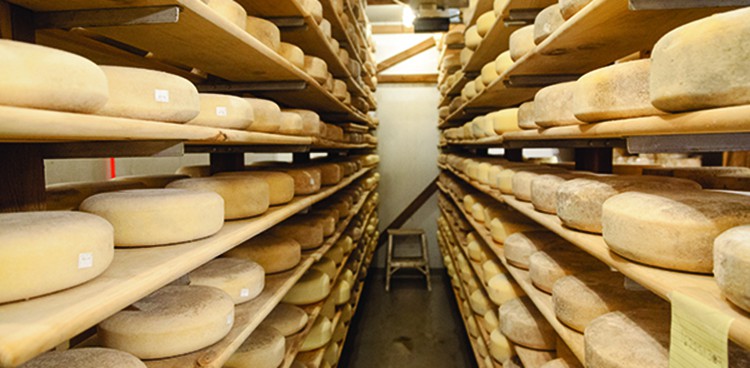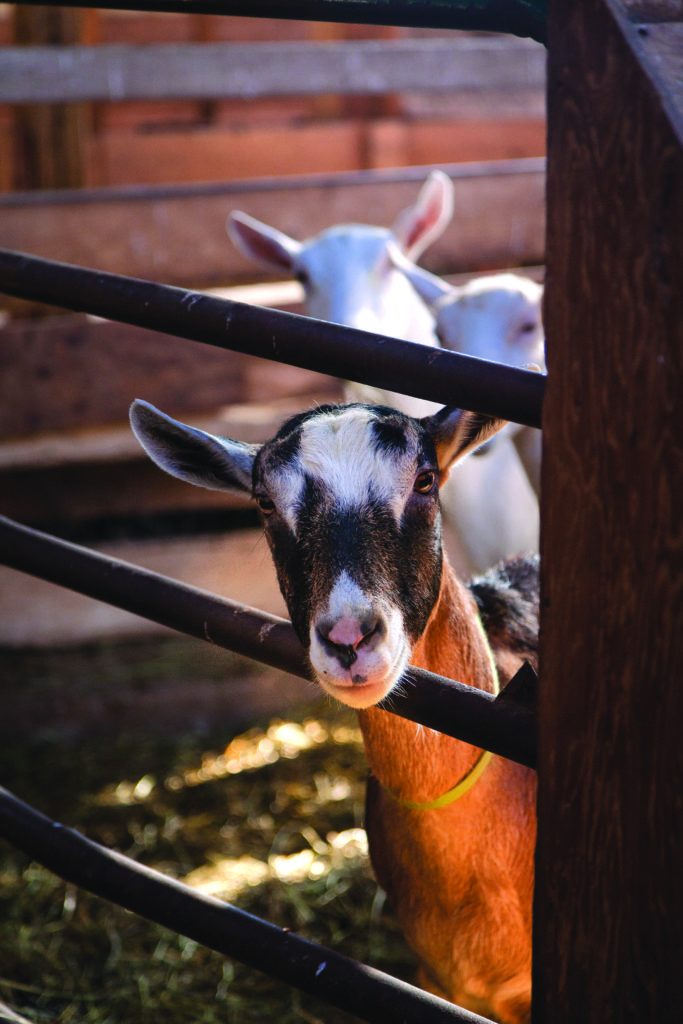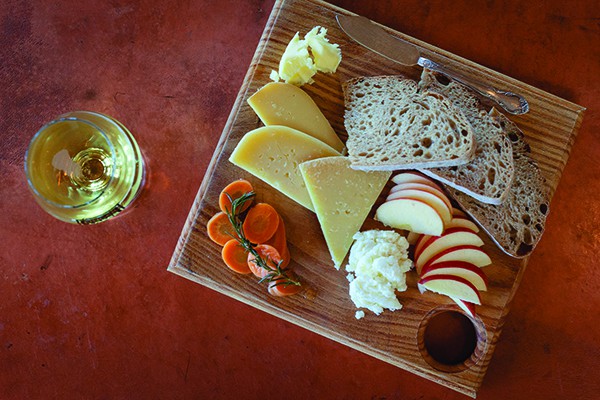
Fair warning: If you ask a Finger Lakes vintner to explain local history, you might get a response in geological time. “370 million years ago,” Bruce Murray begins, as we sit on a terrace at his winery, Boundary Breaks, gazing out onto parallel rows of grapevines gently sloping toward Seneca Lake. Back then, he says, this bucolic landscape lay beneath a sea. After the water retreated, glaciers came, covering the land in mile-thick ice. Over two million years, their thawing waters and jagged bottoms gouged the bottoms of valleys—and when they melted for good, water pooled in the crevices to create 11 finger-shaped lakes.
Narrow and deep, the Finger Lakes warm slowly during summertime and cool slowly come winter, creating a moderating effect on the surrounding hills that protect small buds from damaging early frosts and plump grapes from sweltering summer heat.
The glaciers created the region’s unique microclimate, and something else: “They pushed the soil around,” Murray says. Fay Benson, a dairy specialist at nearby Cornell University, extrapolates: Think of how a rototiller mixes up dirt in the garden, but on a mammoth scale. “Minerals are spread out evenly in the soil,” he says, which has helped other plants flourish. “We have wonderful grasses,” Benson adds.
That’s what Maryrose Livingston, co-owner of Northland Sheep Dairy in Marathon, was looking for when she moved to the Finger Lakes with her husband, Donn Hewes, in 1999. She wanted to make farmstead cheese—“fundamentally, that means we were trying to grow grass,” she says—and here, it “grows like crazy.”
But luscious pasture wasn’t the only temptation the area presented. The couple originally sought farmland in western Washington State but found it too expensive, so they headed due east. “We kept having to look further,” Livingston says, laughing. “And this is where we ended up.”
Dairy State of Mind
Looking out on the sparkling lakes and tapestry of hillside foliage, it’s hard to conceive that land here could be cheap. But Central New York is struggling to adapt to a post-industrial economy. Manufacturing jobs, once the area’s engine, has been streaming from the area since the late 20th century.
Agriculture has changed, too. Abandoned farmhouses dot the terrain, caving in and toppling over as they’re engulfed in vegetation. Many of these homes date to the post-Revolutionary War period when veterans were paid in land that the federal government had seized from the area’s Iroquois tribes.
The ensuing homestead economy flourished until the Industrial Revolution. With the advent of railroads and refrigeration, farms began shipping milk and butter to New York City—and starting in the 1960s, new regulations mandated the use of bulk tanks to store milk. Both trends pushed dairies to get bigger or drop out. Benson, who grew up on a dairy, remembers when most families kept animals. “A lot of farmers had a dairy as their second job, and they didn’t want to make that investment,” he says. “So we lost a lot of them.”
Dairy is still big here—the Finger Lakes is New York’s largest region for milk production, and some counties have more cows than ever before. But that doesn’t mean there are more farmers, says Jerry Bertoldo, a Cornell agricultural specialist: “They just have more cows per square mile.” To survive today’s high overhead and unpredictable prices, a farmer would need several hundred animals. “At that size or bigger, you probably have a chance,” he says.
A Value Proposition
By that standard, Carmella Hoffman’s 50-cow dairy was in trouble. In 2004, after years running a farm that had been in her husband’s family for almost a century, low milk prices forced the Hoffmans into a tight spot. “We kept saying, what are we going to do?” she remembers. “We’d used all our savings to pay the bills and didn’t know how to make any more money doing what we were doing.”
That’s when she began experimenting with cheese in her kitchen, just two gallons at a time.
“I liked what I did,” she says. “And other people liked what I did. So I said, what the heck, let’s figure out how to do this.” Thirteen years later, we’re sitting at a picnic table surrounded by what her family has built over the generations: a sprawling white farmhouse, a big red barn, the adjacent houses of her four children, and Sunset View Creamery’s small on-site cheese shop. Selling cheese has helped the family continue its dairy legacy. “This is where we are,” she says, waving around. “This is what we want.”
Hoffman’s story is a common one, says Pete Messmer, cheesemaker at Lively Run Goat Dairy in Interlaken. “People are realizing that they need to make value-added products to make farms more profitable.”
In the mid-1990s, Messmer’s parents, Susanne and Steven, bought a dairy at the tail end of its long demise. “It was the classic Finger Lakes dairy story,” he says. The farm had been in one family since the 1860s, but the last farmer was getting too old to work. “Milk prices were terrible…it was in rough shape,” he adds.
What began as a line of three farmstead goat’s milk cheeses gradually grew into ten in a range of styles, thanks in part to Pete, who took over cheesemaking in 2013. The 29-year-old has a thoughtful, creative sense, and not just when it comes to crafting wheels.
“I want to make great cheese,” he says, “but I also want to revitalize small-scale agriculture in the area.” To do so, he’s building local partnerships. Some farms supply milk to Lively Run, while others have custom processing arrangements: Messmer makes cheese using their milk, which farms then sell under their own brand names—an opportunity for those unable to invest in expensive facilities.
Lending a Hand
One of those partners is Jessie Slayton, who owns Hemlock Ridge Farm in Avoca with her husband, Kelvin. After selling organic milk to a co-op for years, the young couple was seeking a stable way to market locally. “It’s very exciting,” she tells me a week after Messmer made her first batch of cheese. “It’s more than I imagined we’d be able to accomplish, and it’s because of the support of our community.”
That community is precisely why “small farms are coming back,” Messmer says. Switching from milk to cheese is never simple, but here, resources abound. Besides managing an extension program that works with farmers throughout the state, Cornell University—a land-grant institution with a serious commitment to New York farmers—recently opened a licensed dairy processing plant to budding cheesemakers as part of its Food Science extension. Carmela Beliciu, who manages the Food Processing and Development Laboratory, explains the premise: Aspiring small-scale makers develop a business plan and, if accepted, work out of the facility for 12 to 18 months. During that time, Cornell specialists offer training, education, pasteurization, and milk from the university’s dairy cows delivered directly to the incubator.
“We started this program to promote growth in New York’s dairy industry,” Beliciu says. “For startup companies, the beginning is very hard. We help with regulations and technical advice. We make those first 12 to 18 months a little easier.”
Ever since Mariann Fessenden teamed up with two friends to form Tumino Cheese Company in 2016, the trio has been making Italian-style cheeses at the Cornell facility. That alleviates the stress of licensing a milk plant and buying expensive equipment while figuring out recipes. “The things that would be very daunting as a startup—our hands are held through it,” Fessenden says. “It gives us an opportunity to focus on making cheese.”
The Tumino trio found additional support within the region’s growing cheese community, especially after joining the Finger Lakes Cheese Alliance. Founded by Hoffman of Sunset View Creamery and some other local makers eight years ago as a “Cheese Trail,” the organization recently rebranded to make room for cheesemakers—like Tumino—who don’t have a brick-and-mortar location. By hosting an annual festival and pursuing collective marketing opportunities, the growing group aims to bring dairy recognition to the Finger Lakes as a whole. “Many of our farms are over 100 years old, and they’ve got three or four generations,” says the alliance’s communications director, Mark Costa. “But if you don’t live in the area, you don’t know about them.”
Pairing Up
Indeed, in the scheme of things, the artisan cheese industry is newer here. Many locals see its growth in connection to the region’s other crops—wine especially, which went from being overlooked to lauded after pioneering makers zoomed in on improving quality. “We’re somewhat in the same place that the wine industry was 20 years ago,” Fessenden says.
Pete Messmer agrees: “A handful of [winemakers] started revolutionizing the industry here in the 1990s,” he says, adding that raising the standard for wine kicked off an agritourism boom that’s helping specialty cheese businesses grow. “There’s so much happening here,” Messmer says. “So much emphasis on actual real food.” As evidence, he points to the Finger Lakes Cider House, a tasting room opened in 2015—just two miles from his goat farm—as a collaboration between four local cidermakers. Co-founder Melissa Madden, who bought the on-site orchard 10 years ago, explains that the historic cider-producing region suffered from Prohibition, and has only recently started to bounce back. For the same reasons that grapes flourish here, “the Finger Lakes is a really great place to grow apples,” she says, adding that experimenting with cider-appropriate varieties has been fueled by some “really independent thinkers.” Evidence of that ingenuity spans the selection: from naturally sparkling American oak-aged Barrel Rye Cider, to Royal Cider, a partially fermented ice cider blended with young apple brandy.
Ingenuity on the farm isn’t limited to fruit and dairy. In 2007, grain farmers banded together to establish “micro-mill” Farmer Ground Flour, based in Trumansburg. Milling locally grown grains into made-to-order small batches of spelt, einkorn, emmer, and other flours, the company then inspired the founding of Wide Awake Bakery, which churns out loaves in a wood-burning chamber modeled after 19th-century Spanish ovens. The loaves are sold at farmers’ markets, of which there are no shortages around here. A visit displays the range of local activity: On any given day, one might spot some of Sage Hen Farm’s 70 varieties of heirloom garlic varieties, wild foraged edibles from Thalli Foods, or medicinal mushrooms from Blue Oyster Cultivation.
All Together Now
Tourism, too, has played a major role in bolstering local agriculture. “The area’s natural beauty has parlayed with the wine industry and agritourism to make the Finger Lakes a nice destination,” says Cornell’s Bertoldo, listing temptations that draw visitors in droves: tasting wine, visiting gorges and waterfalls, swimming in lakes, eating at acclaimed restaurants, and—of course—visiting dairy farms.
In addition to delving into the cheese world, the Slaytons have another venture up their sleeves: An on-site farm store. Visitors will be able to picnic, tour, and shop, Jessie says, adding marketing opportunities for the family’s eggs, meat, maple syrup, and cheese. But she’s quick to note: Neighbors can already shop here 24 hours a day. That’s because, she says, “we’re not just looking at this as snack food for tourists. It’s a real food source for our neighbors.”
With some ingenuity, farmers are building a sustainable future in a region that is suffering a steep economic decline. It’s a strategy of diversification—echoing the homesteaders who built their farms here—and it seems promising. “We’re farmers, and we want to pass that on to our children,” Slayton says. “The only thing we can see for miles around is farmland, and it feels right. We’re in our own little world up here.”





